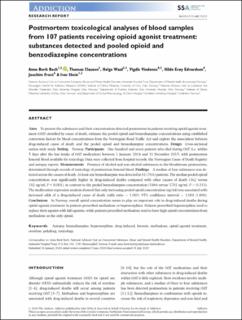| dc.contributor.author | Bech, Anne Berit | |
| dc.contributor.author | Clausen, Thomas | |
| dc.contributor.author | Waal, Helge | |
| dc.contributor.author | Vindenes, Vigdis | |
| dc.contributor.author | Edvardsen, Hilde Marie Erøy | |
| dc.contributor.author | Frost, Joachim | |
| dc.contributor.author | Skeie, Ivar | |
| dc.coverage.spatial | Norway | en_US |
| dc.date.accessioned | 2021-10-22T08:30:44Z | |
| dc.date.available | 2021-10-22T08:30:44Z | |
| dc.date.created | 2020-09-30T10:32:22Z | |
| dc.date.issued | 2020 | |
| dc.identifier.citation | Bech, A. B., Clausen, T., Waal, H., Vindenes, V., Edvardsen, H. E., Frost, J., & Skeie, I. (2020). Post-mortem toxicological analyses of blood samples from 107 patients receiving opioid agonist treatment: substances detected and pooled opioid and benzodiazepine concentrations. Addiction (Abingdon, England), 10.1111/add.15211. Advance online publication. Https://doi.org/10.1111/add.15211 | en_US |
| dc.identifier.issn | 0965-2140 | |
| dc.identifier.uri | https://hdl.handle.net/11250/2824907 | |
| dc.description.abstract | Abstract
Aims: To present the substances and their concentrations detected post-mortem in patients receiving opioid agonist treatment (OAT) stratified by cause of death, estimate the pooled opioid and benzodiazepine concentrations using established conversion factors for blood concentrations from the Norwegian Road Traffic Act, and explore the association between drug-induced cause of death and the pooled opioid and benzodiazepine concentrations.
Design: Cross-sectional nationwide study.
Setting: Norway.
Participants: One hundred and seven patients who died during OAT (i.e. within 5 days after the last intake of OAT medication) between 1 January 2014 and 31 December 2015, with post-mortem femoral blood available for toxicology. Data were collected from hospital records, the Norwegian Cause of Death Registry and autopsy reports.
Measurements: Presence of alcohol and non-alcohol substances in the bloodstream at time of death, determined through records of toxicology of post-mortem femoral blood.
Findings: A median of four substances was detected across the causes of death. At least one benzodiazepine was detected in 81 (76%) patients. The median pooled opioid concentration was significantly higher in drug-induced deaths compared with other causes of death (362 ng/mL versus 182 ng/mL, P < 0.001), in contrast to the pooled benzodiazepine concentration (5466 versus 5701 ng/mL, P = 0.353). The multivariate regression analysis showed that only increasing pooled opioid concentration (ng/ML) was associated with increased odds of a drug-induced cause of death (odds ratio, 1.003; 95% confidence interval: 1.001-1.006).
Conclusions: In Norway, overall opioid concentration seems to play an important role in drug-induced deaths during opioid agonist treatment in patients prescribed methadone or buprenorphine. Patients prescribed buprenorphine tend to replace their agonist with full agonists, while patients prescribed methadone tend to have high opioid concentrations from methadone as the only opioid.
This article is protected by copyright. All rights reserved. | en_US |
| dc.language.iso | eng | en_US |
| dc.publisher | Wiley | en_US |
| dc.rights | Navngivelse-Ikkekommersiell-DelPåSammeVilkår 4.0 Internasjonal | * |
| dc.rights.uri | http://creativecommons.org/licenses/by-nc-sa/4.0/deed.no | * |
| dc.subject | Autopsy, | en_US |
| dc.subject | benzodiazepine, | en_US |
| dc.subject | buprenorphine | en_US |
| dc.subject | drug | en_US |
| dc.subject | induced | en_US |
| dc.subject | forensic | en_US |
| dc.subject | methadone | en_US |
| dc.subject | opioid agonist treatment | en_US |
| dc.subject | overdose | en_US |
| dc.subject | polydrug | en_US |
| dc.subject | toxicology | en_US |
| dc.title | Postmortem toxicological analyses of blood samples from 107 patients receiving opioid agonist treatment: substances detected and pooled opioid and benzodiazepine concentrations | en_US |
| dc.type | Peer reviewed | en_US |
| dc.type | Journal article | en_US |
| dc.description.version | publishedVersion | en_US |
| dc.rights.holder | © 2020 The Authors. Article published by John Wiley & Sons Ltd. on behalf of Society for the Study of Addiction. This is an open access article under the terms of the Creative Commons Attribution NonCommercial License, which permits use, distribution and reproductionin any medium, provided the original work is properly cited and is not used for commercial purposes. | en_US |
| dc.source.pagenumber | 11 | en_US |
| dc.source.journal | Addiction | en_US |
| dc.identifier.doi | 10.1111/add.15211 | |
| dc.identifier.cristin | 1835335 | |
| dc.relation.project | [Hospital Innlandet Trust]: [150351] | en_US |
| cristin.ispublished | true | |
| cristin.fulltext | original | |
| cristin.qualitycode | 2 | |

